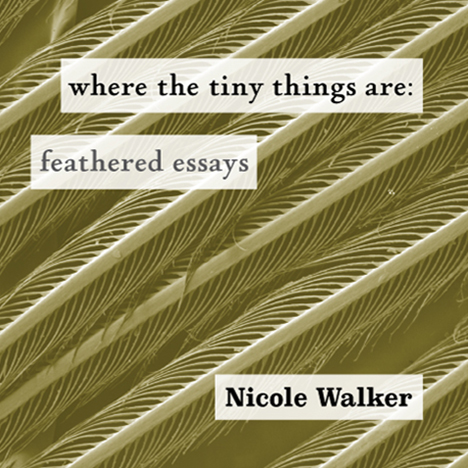In this collection of longer essays nested within brief, lyrical meditations, each piece focuses on some micro aspect of everyday life as a means of exploring complex macro systems—families, dinner parties, vineyards, deserts, nations. For example, Walker’s own experience as the mother of a micropreemie (a baby born weighing less than one pound, twelve ounces, or before twenty-six weeks gestation), “the smallest thing in the world,” spurs an exploration of, among other things, the economics of health care, the causes of premature births, and the ethics of extreme interventions. Where the Tiny Things Are is a book of ideas and an exploration of science. It is of the world and of the heart – both intensely personal and expansively empathetic.
TABLE OF CONTENTS // Microscopium, Micromeat, Microbarriers, Microsurgery, Microencephaly, Microlecithal, Micropreemies, Microbortions, Microkeratome, Microbladder, Microclimates Lower Sonoran, Micromeria, Microbursts, Micro Prairie Dogs & Micro Turkey Vultures, Micro Snow Leopard, Microorganisms, Micromanagement, Micronize, Microhabitat, Neutrinos, Microwine, Microwind, Microgalaxy, Microwindmills, Microhematocrit, Microsoccer, Microtrain, Microblogs, Microfire, Microtopography, Micromeasures, Microgas, Microisland, Microspikes, Distracted Parents of the Micromanagement Era, Microhaboobs, Microbivalves, Biofuels Will Take You Home, Microbags, Microbiotics, Microapocalpyse
Nicole Walker on the microessay:
I don’t sleep very well at night. I feel like I’m drowning. Thoughts race by and I can’t catch one of them long enough to linger, to figure out a solution, to find a way to resolve it so I can get some sleep. Oyster reefs, salmon, school budget cuts, Planned Parenthood, dying frogs, bats with fungus—it’s a constant stream of disaster and I can’t make myself turn it off. I spend too much time on the Internet reading status updates and news briefs. I can’t help posting to Facebook about the polar bear who, along with her cub, swam for nine straight days looking for an ice floe. She swam as far as she used to swim to get to some ice but found no ice there. She swam a little farther. Nothing but open water. Winter in the northern hemisphere isn’t supposed to be this blue. She couldn’t tell day from night, but she could tell when her cub went missing. He had been swimming alongside her. Then he was gone. She couldn’t see through the dark to where exactly he’d drowned, but the splashing ocean that he’d been flailing in was now quiet. After nine days, after swimming without fins or gills, after swimming against current and across deep trenches, she finally hit a block of ice big enough to rest on. Weighing nearly half as much as she had when she’d left land, the bear pulled her exhausted body up onto the floe.
The day after the polar bear story appeared, NPR’s Marketplace hosted a segment on about the way people tune out when they hear about global warming. There’s too much to think about there. The ear, let alone the mind, isn’t big enough to contain all the horror.
But people live for a tiny bit of hope. These tiny bits of good news accumulate. Some bits of good news even accumulate enough to make a dent in some of the bad news. Some small acts might even accrete to save the polar bear. Maybe not. I am full of want and hope. I cling to the idea that as the whale population recovers, whale poop can help sequester carbon. That tiny rhizomes sink carbon into soil. That miniature turbines roll back and forth in the ocean tide, making clean energy, enough to propel a country.
Maybe the small isn’t just a distraction from the bigger issues. Maybe the small is key. Maybe the small provides an answer this way: if you look closely enough, there are solutions in those distractions. Or, rather, the small is a way to make us think in new ways, to learn how to make small adaptations to survive big changes. If you open your mind wide enough, maybe you can imagine that small things can help undo some of the damage to the whole, big planet. If I could stop and look at that mouth, that lip, or maybe it’s more of a tongue, of a pinecone? What if that square of bark explained something about the cellular structure of trees? Sand is geologic. It’s the sign of what kind of minerals can be found underground and a sign of the way the water might flow. I’m not a scientist. I was trained as poet. Like the scientist, I want to look closely. I want to pull ideas out of a grain of sand, to learn the seductive charms of pinecones, to plumb the back-scratching potential of a square of bark. Maybe by paying attention to the small things, you can become more like them—adaptive, responsive, embracing.


